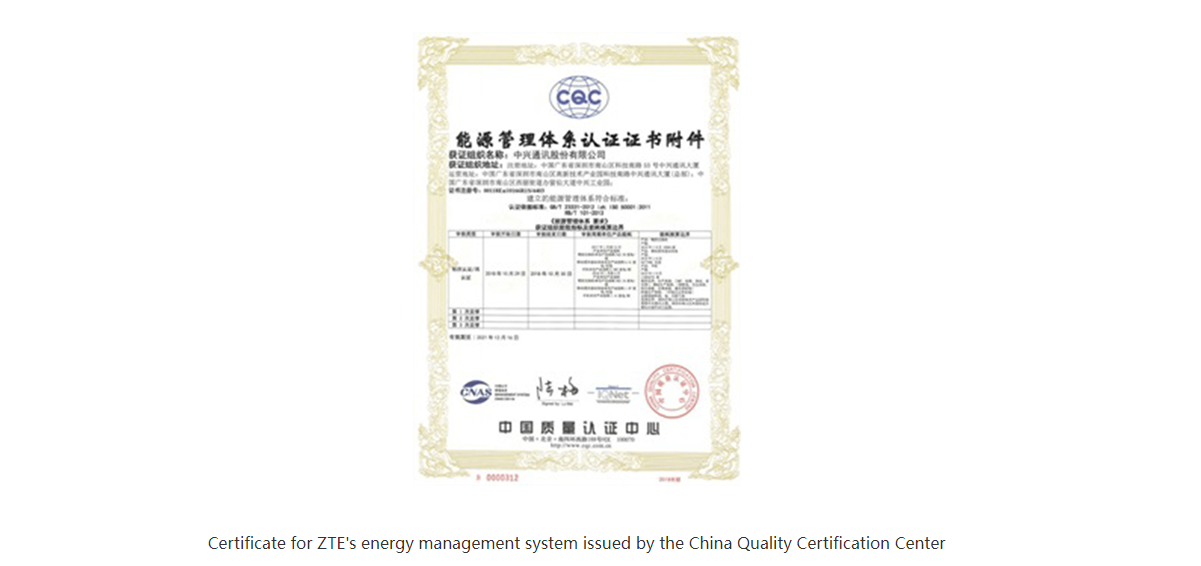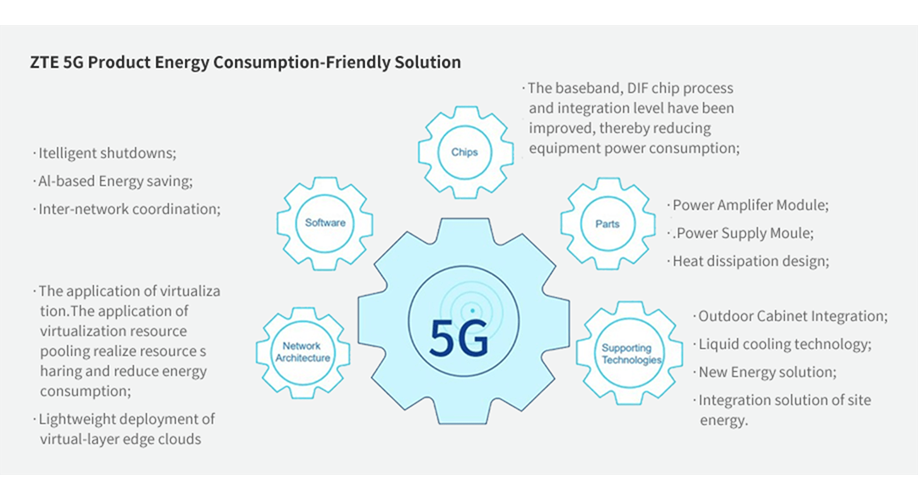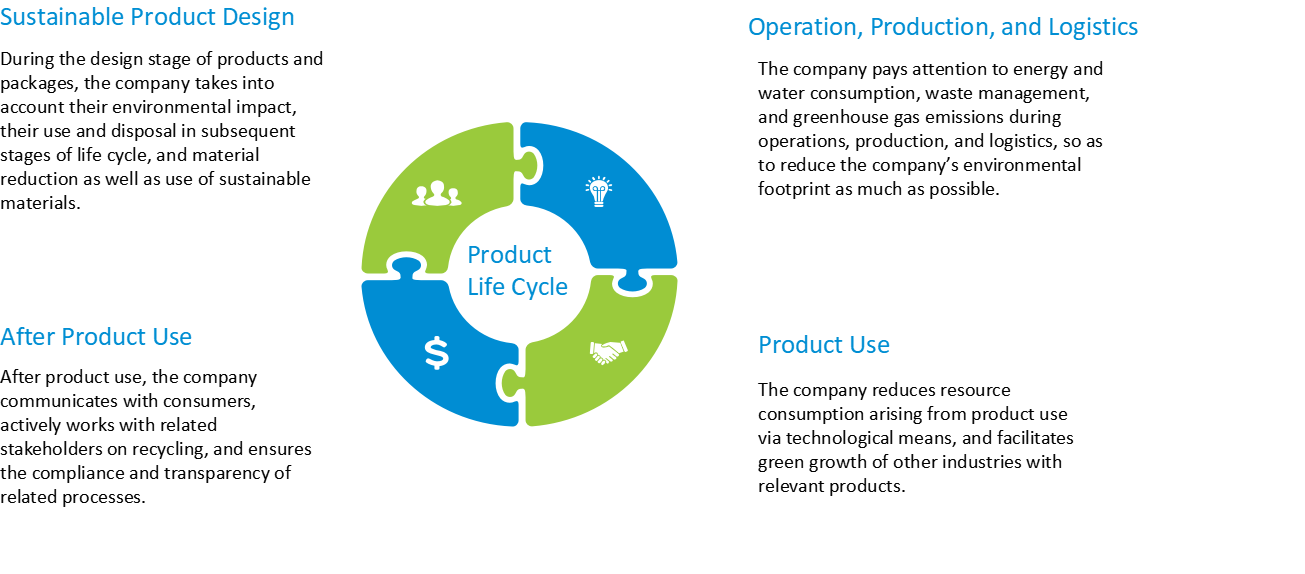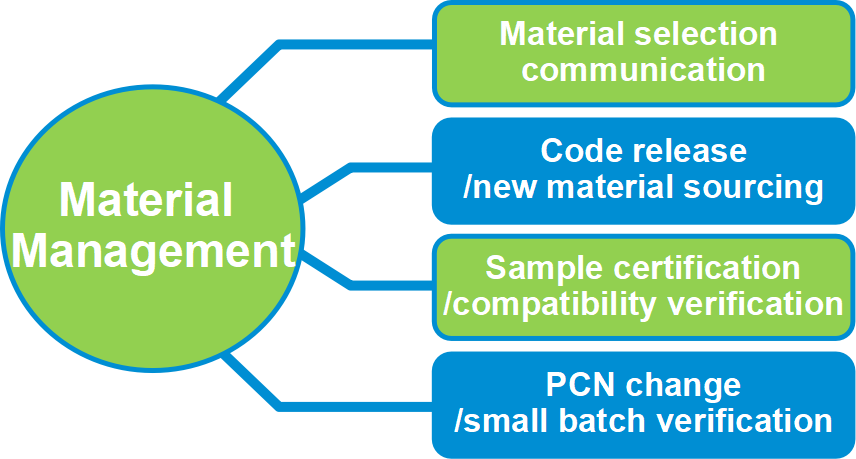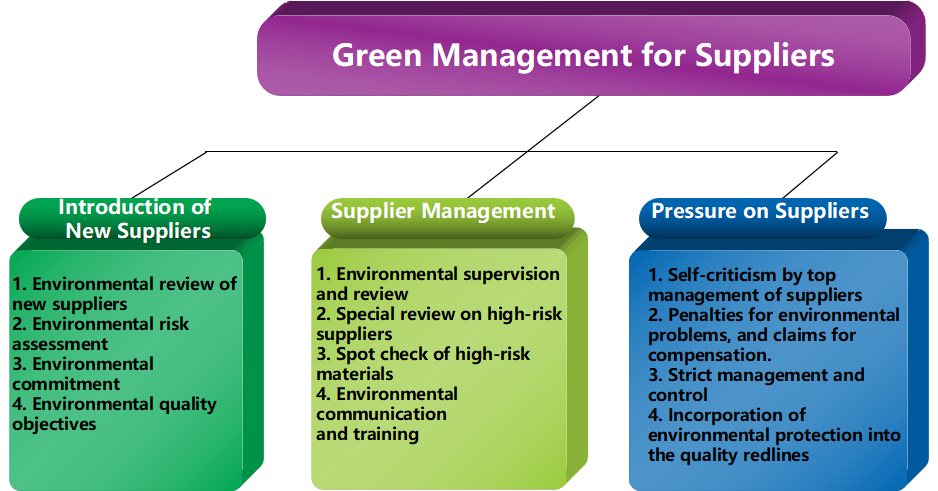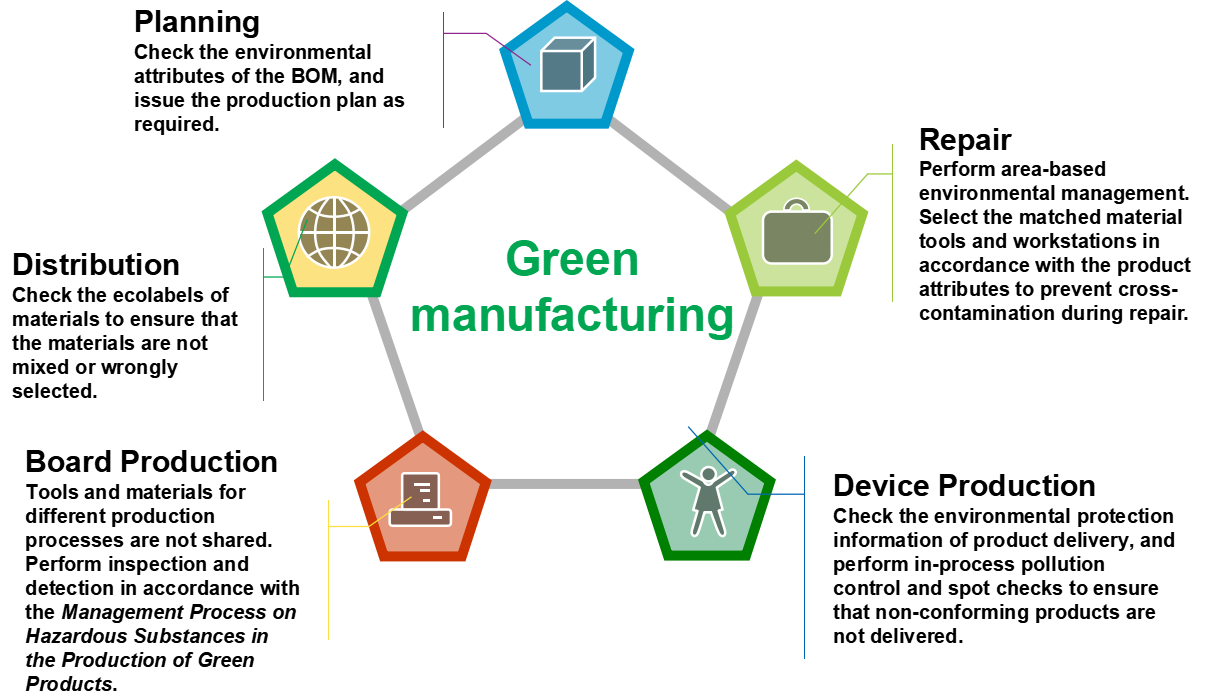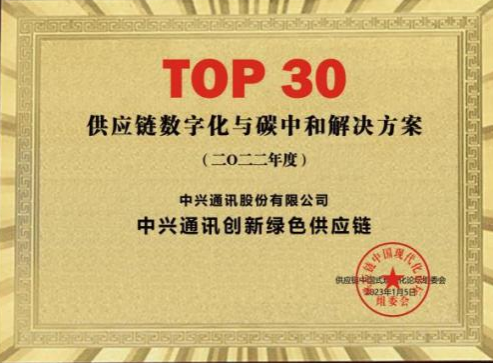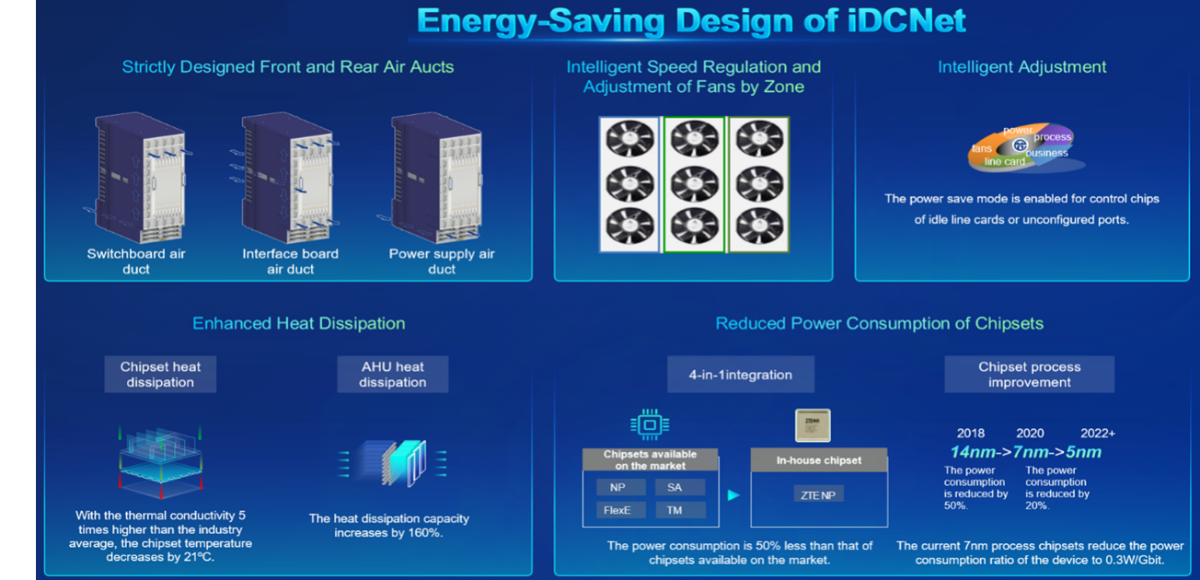In ZTE, the philosophy of green growth takes root in all production and operation activities. With increasing environmental problems, countries around the world are raising higher requirements for the environmental performance of electronic and electrical products. For example, countries in Europe and America are continuously updating their environmental laws and regulations, and high-end customers are proposing more environmental protection demands. ZTE has been committed to the research and exchanges about environmental protection standards with international standards organizations such as the International Telecommunication Union (ITU), standards working groups of China, and industry associations including the Institute of Printed Circuits (IPC). Also, the company has been working with suppliers to promote the reduction, elimination, and substitution of hazardous substances in materials and manufacturing processes, and constantly updating its hazardous substance control standards. Through these efforts, we strive to build a green supply chain to comply with the environmental laws and regulations of relevant countries and regions and ultimately achieve sustainable development.
ZTE has made great contributions to reducing hazardous substances in electrical and electronic products. In recent years, we have actively participated in the drafting and comparison of the IEC 62321-12 standard of the International Electrotechnical Commission for determining certain substances in electronic products. In addition, we have participated in the drafting and revision of seven standards in the GB/T39560 series for the testing methods of hazardous substances in electrical and electronic products and two industry standards for the management of hazardous substances, namely the Guide of Risk Assessment for Hazardous Substances in Electrical and Electronic Products and Guide to the Management and Implementation Evaluation of Hazardous Substances in Electrical and Electronic Products. These standards provide guidance for electrical and electronic enterprises on the management of hazardous substances. Furthermore, we have offered suggestions on the conformity assessment of the restricted use of hazardous substances and the requirements for the labeling of hazardous substances in China, promoting the management of hazardous substances at both industry and national levels.
In accordance with the Three R's Framework (reduce, reuse, and recycle) of the circular economy and the requirements in the ISO 14040 Environmental Management – Life Cycle Assessment – Principles and Framework, ZTE actively fulfills its environmental responsibilities, and integrates the low-carbon concept into the entire product life cycle, from customer demands, product design/R&D, raw material verification, product processing, product sales, to product recycling and disposal.
ZTE continuously extends the management scope of environmental protection, and strengthens the establishment and optimization of management mechanisms, green design, green manufacturing, green recycling, and supplier management.
(1) Mature Green Product Management System
By analyzing the environmental laws and regulations of countries and regions around the world, ZTE has sorted out the environmental compliance risks in business, and formulated a landscape of the global environmental laws and regulations. Based on the IECQ QC 080000 Hazardous Substance Process Management system and the risk assessment, the company has developed a green product control system consisting of one manual, one general regulation, and 45 specific regulations. Specifically, the overall requirements and policies of the QC 080000 system are integrated into the Quality Management Manual, and the management requirements for the design, material selection, procurement, distribution, manufacturing, and supply chain of green products are specified in the Regulations on the Management of Green Products. More specific requirements are stipulated in 45 regulations, such as the Requirements for Banned and Restricted Hazardous Substances, Requirements for Eco-Labels, and Methods for Measuring the Concentration of Harmful Substances Prohibited and Restricted to Use. Through such system, we have ensured environmental protection in the end-to-end business processes such as marketing, R&D, production, and after sales.
In 2022, in response to the changes in external policies and regulations, ZTE analyzed environmental compliance risks promptly, and revised six corporate standards based on the QC 080000 system, ensuring that the hazardous substance management system was in line with related laws and regulations and that the response measures were effectively implemented.
| Compliance Risk and Challenge |
ZTE's Response |
| Requirements of the EU Restriction of Hazardous Substances in Electrical and Electronic Equipment (RoHS) 3.0 Directive: The EU proposed to incorporate Medium Chain Chlorinated Paraffins (MCCPs) and Tetrabromobisphenol A (TBBP-A) into RoHS control. |
Developed methods and conducted risk assessment for the MCCPs and the TBBP-A. |
| RoHS exemption update: The EU issued the final evaluation report of exemption clauses of Pack 22 of RoHS Directive. |
Closely tracked the exemption update, promptly analyzed the changes and updated related materials accordingly. |
| Requirements of Regulation (EC) No 850/2004 on Persistent Organic Pollutants (POPs): The list of controlled substances include short-chain chlorinated paraffins (SCCPs) and perfluorooctanoic acid (PFOA). |
Updated the requirements for the HSF-S environmental protection attribute, issued an announcement letter about the POPs, and added a marking module about the POPs in the IT system. |
| SCIP database declaration: SCIP database declaration of products sold in the EU according to the requirements of the EU Waste Framework Directive (WFD). |
Uploaded more than 200 files effectively based on related delivery plans as of December 2022, and released the Regulations on Submitting SCIP Dossiers for ZTE Products. |
| Requirements of Toxic Substances Control Act (TSCA) and Toxics in Packaging Clearinghouse (TPCH): TSCA requires the control of five Persistent, Bioaccumulative and Toxic (PBT) chemicals, and ortho-phthalates and per- and polyfluoroalkyl substances (PFAS) were added as regulated chemicals in TPCH. |
Incorporated the new regulatory requirements into the Requirements for Banned and Restricted Hazardous Substances, and informed the supply chain of such requirements. |
[Case] Active Response to the EU Regulation on POPs and RoHS 3.0 Directive
In response to the impact of the EU regulation on POPs and the upcoming RoHS 3.0 on the telecommunications industry, ZTE has developed testing methods for the SCCPs and MCCPs included in RoHS 3.0. We purchased GC-NCI MS testing equipment, and redesigned and renovated our lab for the testing of SCCPs and MCCPs. Our testing methods comply with related national standards, namely the Determination of Short Chain Chlorinated Paraffins in Electrical and Electronic Products — Gas Chromatography-Mass Spectrometry and Determination of Medium Chain Chlorinated Paraffins in Electrical and Electronic Products — Gas Chromatography-Mass Spectrometry, and have been recognized by the China National Accreditation Service for Conformity Assessment (CNAS).
(2) Green Design and Technology-Driven Power Saving
As always, the communications industry regards power saving and low carbon as key issues for sustainable development. With the advent of the 5G era, the power consumption of 5G base stations and terminals has become a major focus of the society. ZTE has been proactively exploring the methods for further reduction of energy consumption of base stations, with over 500 green 5G patents filed. Relying on self-developed high-performance chips, high-efficiency power amplifiers, and industry-leading structural design, ZTE has increased efficiency and reduced power consumption through advanced technologies, and worked with operators to build green 5G networks.
During product design and development, ZTE analyzes the customer demands and identifies the environmental laws and regulations as well as industry standards in the place of origin and sales, including but not limited to environmental protection requirements for hazardous substances, product recycling, energy efficiency, and packaging. Materials with high durability are used preferentially to reduce consumption. Also, appropriate materials and solutions are adopted for easy recycling and reuse, to reduce the size and weight of packaging materials. While meeting the technical, security, functional, and market requirements, ZTE adheres to the philosophy of design for recycling. The company carries out design activities based on such principles as easy removal, recycling, and reuse, as well as reduction of material types and quantities and extended lifespan.
Countries and regions have attached greater importance to and promoted the environmental performance assessment and low-carbon development throughout the full life cycle of products. Against such background, ZTE has established a team of product Life Cycle Assessment (LCA), introduced professional assessment software (GaBi) and corresponding databases, and built the capability for independent LCA, in strict accordance with the requirements in ISO 14040, ISO 14044, and ISO 14067. The LCA involves multiple environmental indicators, such as greenhouse gases, water footprints, acid rain, and eutrophication.
In 2022, ZTE formulated and released the Product LCA Carbon Footprint Assessment Specifications to strengthen product life cycle management and standardize the product LCA. We actively conducted the LCA to evaluate the Global Warming Potential (GWP) of our products throughout their life cycle from raw material extraction, manufacturing, distribution, use, to product end of life. In 2023, ZTE plans to establish a database for the carbon footprint of products, to shoulder the company's CSR in terms of carbon reduction while responding more quickly and accurately to customers' requirements for the LCA.
In 2022, ZTE continued to take a series of energy-saving and carbon-reduction actions. Focusing on the use phase of products, the company effectively cut carbon emissions through carrier shutdown, equipment deep sleep, channel shutdown, and symbol shutdown function for traffic products. Also, ZTE employed site photovoltaic applications and simplified site solutions for energy-intensive products. As for terminal products, our actions covered the entire life cycle to further reduce the carbon emissions, for example, increasing the packaging capacity, substituting paper manuals with electronic ones, reducing plastic packages, using Post-Consumer Recycled (PCR) plastics, and adopting non-spraying processes.
[Case] Contributions to the Formulation of Low-Carbon Standards
Based on its industry practices, ZTE has been actively collaborating with Chinese and international research institutions and industry associations to compile, revise, and issue relevant product standards, promoting green and low-carbon development. Meanwhile, by virtue of our experience in standards formulation, we have developed assessment methods in line with industry standards and enhanced expertise in this regard. In 2022, ZTE mainly engaged in the following standards activities.
- The drafting of Shenzhen's Technical Specifications for Product Carbon Footprint Assessment: Mobile Phone, which has been officially released.
- The drafting and revision of the Electric and Electronic Product Carbon Footprint Assessment Part 4: Mobile Communication Handset, a group standard for carbon accounting, and the Data Center Carbon Emission Control Specifications and Data Center Carbon Label Assessment Specifications, group standards for data center carbon footprint.
- The communication on product LCA with operators, and the drafting of the White Paper on Synergetic Carbon Reduction in the Value Chain and Supply Chain of Information and Communication Enterprises.
Adhering to the green concept of power saving and consumption reduction, ZTE has formulated the technical requirements for communications products and the standards for tests on a series of communications products, in accordance with customer demands and standards in China and abroad. From design to verification, ZTE has ensured that its products meet certification requirements such as the EU's Energy-Related Products Directive (ErP) (2009/125/EC) and Code of Conduct on Energy Consumption of Broadband Equipment (COC), as well as the requirements by the U.S. Department of Energy (DOE), California Energy Commission (CEC), Energy Star Program of the U.S., Canada's Natural Resources Canada (NRCan), Australia's Minimum Energy Performance Standards (MEPS), and China's related requirements.
[Case] Internet Data Center (IDC) Solution
An ideal PUE (100% efficiency) of data centers has been a long-term pursuit. Based on a deep understanding of the energy-saving methods for data centers, ZTE has been making technological innovations in terms of power supply and distribution as well as Heating, Ventilation, and Air Conditioning (HVAC). For example, the company has developed the High Voltage Direct Current (HVDC) solution. Compared with the traditional solution of Uninterruptible Power Supplies (UPSs), it has reduced DC/AC transmission, thus improving efficiency. Currently this solution has been widely applied in the Internet industry and by the major Chinese operators.
In terms of HVAC, the company's IDC solution makes full use of natural cooling sources. The chilled-water air-conditioning system has a complicated architecture and contains multiple subsystems, such as the air-conditioning end, chiller, water pump, cooling tower, and water storage tank. Such system requires high initial investment and features inflexible expansion. In contrast, indirect evaporative air conditioners adopt a modular and prefabricated design to reduce initial investment and enable flexible expansion, and also natural cooling is used to further improve energy efficiency.
In addition, the IDC solution enables AI-based power saving. Based on indicators including the environmental characteristics, total IT load, and device parameters, the mathematical model of PUE is output through model training, automatically learns the optimal operation policy and configures parameters. As indicated in the company's test, the power saving ratio can be increased by 8%.
AI-based energy-saving is also applied to ZTE's BN and FN products. When network equipment or module is idle or underloaded, it can automatically be shut down or enter low-power-consumption mode to save energy. In addition, each module of a network device, including the optical module, forwarding module, switching module, and cache, can be hibernated dynamically to reduce power consumption. Moreover, the self-adaptive traffic control technology is used to develop effective hibernation policies by perceiving traffic patterns, and identify the optimal conditions and timing for enabling or disabling hibernation, avoiding packet loss and additional power consumption caused by mode switching.
(3) Supplier and Material Management to Control Environmental Risks at Source
ZTE controls environmental risks at source through material management, supplier management, and incoming material inspection.
1. Material management: Throughout the material management process from selection communication, code release, prototype adoption, to PCN, the environmental reports and other environmental compliance materials are available, ecolabels and environmental commitments for materials are completed, and incoming materials are inspected for environmental protection.
2.Supplier management: The environmental performance of products mainly depends on the management and control capabilities of suppliers. During the introduction of new suppliers, we conduct environmental review and risk assessment strictly. During the cooperation, supervision and review are conducted, with special environmental review performed on high-risk suppliers. Through incorporating environmental protection into the quality redlines, the environmental protection capability of suppliers can be improved.
ZTE has formulated the Regulations on Environmental Risk Assessment and Management Regarding Suppliers' Products, and determined the environmental risk levels of suppliers to perform hierarchical management. From the dimensions of suppliers and materials, the 9-box grid model (see the following figure) has been established to refine the sampling mechanism and to manage high-risk suppliers and materials more effectively.
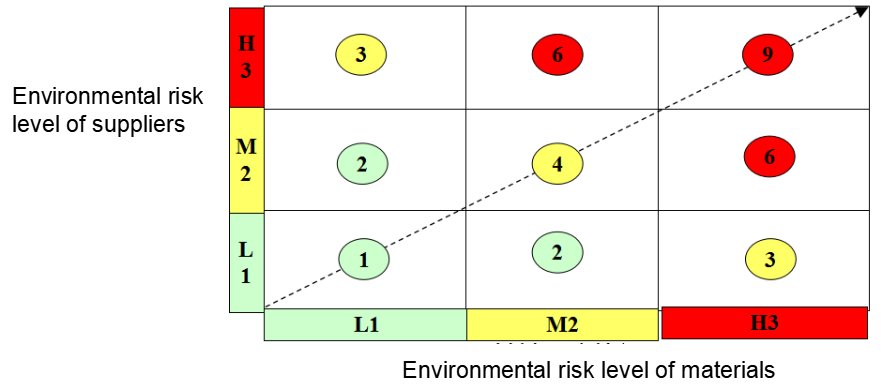
3.Incoming material inspection: Sampling inspection plans for incoming materials are formulated in accordance with the environmental risks of materials and suppliers. First, inspections are performed based on the environmental attribute requirements of the materials. Then, environmental test solutions are formulated in accordance with the environmental risks of materials and suppliers. After the non-conforming materials are optimized, stricter tests are performed on the subsequent three batches of incoming materials from the suppliers. After passing the tests, the suppliers will receive spot-checks as high-risk suppliers.
Through project operations, ZTE has improved the environmental management capability of the supply chain. The company has developed an environmental protection audit mechanism of "risk identification > risk confirmation > risk reduction > risk elimination", and carried out environmental risk assessment on all suppliers. In 2022, the company began the on-site inspections by stages on the high-risk suppliers identified. Up to now, about 20% of the suppliers have been audited, to which the company have provided guidance. Moreover, for nonconformities found in the inspections, we tracked their status in IT systems, conducted cause analysis, and formulated rectification measures to ensure closed-loop management. In this way, the suppliers can improve their management systems and better assist ZTE in hazardous substance management.
- Self-assessment and self-inspection of environmental protection: ZTE requires suppliers to make self-assessment and self-inspection in five dimensions, namely system building, incoming materials, production process, design development and change, and material and supplier management. Besides, ZTE has carried out conformity confirmation and offered guidance to suppliers.
- Incoming material inspection: The company has continuously stepped up its efforts to conduct environmental inspections in each industrial park and detect and prevent environmental problems of suppliers' materials. By doing so, we aim to send a clear signal to suppliers that the company highly values environmental protection, so as to promote the improvement of suppliers' environmental management capabilities.
- Training and support: The company has also kept enhancing the professional capabilities of suppliers through top-level meetings and special training related to environmental protection. In 2022, we delivered training for 460 suppliers.
(4) Green Manufacturing to Ensure No Flow of Hazardous Substances
During the production process, ZTE strictly follows the "Three Nos" principle for quality management. Specifically, the inspection requirements of "no inflow, no generation, and no outflow of nonconforming products" are set for the four key procedures, namely material incoming process and distribution, board production, device assembly, and finished product warehousing and delivery. With these efforts, we strive to ensure that the final products delivered meet the environmental laws and regulations and the customer's environmental compliance requirements.
As for the quality control in green production, ZTE ensures that the environment protection information of products is accurately transferred to the production phase. Moreover, the company specifies the corresponding procedures and conditions required for eco-friendly products as early as in the pilot production phase, including the selection and use of tooling and auxiliary materials.
Green manufacturing involves the phases of planning, distribution, production, and repair, where the environmental attributes of the BOM are identified. During planning, the environmental attributes of the material code shall be checked. In the distribution phase, materials shall be classified in accordance with the ecolabels. In the production phase, in addition to avoiding mixing and wrongly selecting materials, the materials used in different production processes shall also be well managed. Line bodies, auxiliary materials, and fixtures with different environmental attributes for dedicated production lines shall not be shared, realizing environmental management for different areas. In terms of production, the environmental attribute of the first piece is strictly inspected, and only after the inspection is passed can production starts. During the repair process, the focus lies in preventing cross-contamination.
(5) Green Recycling Through Responsible Treatment of End-of-Life Products
ZTE fully recognizes its corporate social responsibilities in terms of recycling. "Safe, Eco-Friendly, Professional" is ZTE's recycling management policy. The company strictly abides by the regulations on management of waste from electronic equipment in all countries, and actively promotes the recycling and reuse of waste products. For example, the company has established professional departments that are responsible for recycling and reuse.
For scrap recyclers, ZTE conducts closed-loop management from bidding, contract implementation, to contract fulfillment to ensure compliance. Management methods include announced and unannounced on-site inspections of materials for key projects, regular collection of the Report on Destroying Scrapped Materials, classified management, and annual performance appraisal.
In external cooperation, ZTE works closely with the world's leading environmental service providers to establish a global network for handling recycled materials. This can enable one-stop disassembly and recycling of telecom equipment across the globe, so that electronic waste can be handled, recycled, and reused in an eco-friendly manner.
ZTE strictly abides by the management requirements for the cross-border transfer of hazardous wastes as specified in the Basel Convention, and actively works with local service providers to recycle and reuse waste. Moreover, the company has set up a general control platform for recycling at its headquarters in Shenzhen, China. By 2021, its recycling system had covered 140 recycling points worldwide. In 2022, ZTE processed 1,571 tons of wastes and achieved an overall recycling rate of 97% in China by optimizing four waste recycling platforms and collaborating with more than ten industry-leading environmental protection agencies, which provided professional and efficient recycling services. In overseas markets, ZTE processed 504 tons of waste and achieved an overall recycling rate of 98% in 2022 through in-depth long-term cooperation with over 150 environmental protection agencies in Asia, Europe, Latin America, and Africa, to ensure that the recycling meets the environmental protection requirements where we operate. As for mobile device business overseas, the company has over 100 authorized repair centers for recycling and processing mobile devices that are dead on arrival in accordance with environmental protection requirements. In China, ZTE promotes mobile device recycling through its official website, ZTE mall, and third-party recyclers to reduce environmental pollution.
For products that need to be recycled, optimal material handling plans are proposed after the evaluation of multiple parties based on the actual state of the materials, reusability, cost of return, customs requirements, and local regulations. And the materials are reused in strict accordance with the evaluation results as well as the testing and inspection processes.
In terms of green circulation, we reduce wastes at source through resource reallocation, problem rectification, and equipment disassembly, thus significantly increasing the reuse rate of returned materials. In addition, we have built a global green circulation network consisting of over 150 environmental protection service providers, and recycled 1,418 tons of metal and 61 tons of plastic throughout the year of 2022.
In 2022, "ZTE Innovative Green Supply Chain" was awarded the "Top 30 Enterprises of Supply Chain Digitalization and Carbon Neutral Solutions in 2022" jointly by the Logistics Supply Chain Service Assurance Alliance and the organizing committee of the Forum on Supply Chain Modernization in Chinese Style.
(6) Green Product Innovation
By integrating the concept of sustainable development into product life cycle management, ZTE actively builds green infrastructure, innovates in low-carbon products and solutions, and applies eco-friendly product packaging and transportation. In this way, the company is committed to helping enterprises reduce costs and increase efficiency and cope with climate change.
1. Green Infrastructure
While digital infrastructure promotes rapid social development, its power consumption and carbon emissions have raised more concerns. To address these concerns, ZTE continuously builds green digital infrastructure, and establishes and optimizes green technology systems, develops and applies energy-saving and low-carbon technologies. Through these practices, we significantly improve the Power Usage Effectiveness (PUE) of digital facilities, fully tap our potential in carbon reduction, and effectively coordinate digital and green development.
Based on its in-house chipsets, ZTE promotes the deployment of green infrastructure to enable green sites, green data centers, and low-carbon energy for energy-hungry products and solutions.
- Green sites: The macro sites in the form of traditional equipment rooms have gradually evolved into cabinet-based sites, which will develop into pole sites in the future as the integration is further enhanced, thus carbon emissions will be slashed. Small steps made on each product will ultimately lead to giant leaps and create great value.
- Green data centers: Energy-saving technologies are fully applied to improve the PUE from three aspects—flexible energy use, extreme cooling, and intelligent management. In some areas, the PUE is reduced to less than 1.2. With prefabricated data center solutions, the construction period is shortened by 40%. Through on-demand capacity expansion, the initial investment is reduced by 30%.
- Low-carbon energy: ZTE's intelligent photovoltaic system provides green power for sites, equipment rooms, and data centers, realizing photovoltaic applications in all scenarios. With innovative functions such as the hybrid use of intelligent lithium batteries and legacy batteries, intelligent peak shaving, as well as the split control and remote management of power, we have enabled precise and intelligent power supply, and further improved the PUE.
At the same time, ZTE actively promotes digital transformation in energy, including AI-based energy cloud, green power generation, and intelligent energy storage, to speed up carbon neutrality.
[Case] Energy-Saving Design of iDCNet
2. Low-Carbon Product Design and R&D
ZTE has established many R&D laboratories located all over China. A challenge confronting the laboratories is the high power consumption in the manufacturing of boards and devices for 4G and 5G base stations. In response, we use remote automation to enable energy-saving functions at base stations. Since the deployment of energy-saving functions in 2022, ZTE has saved more than 1.5 million kWh of electricity, which is equivalent to saving 468 tons of coal or planting 133,712 trees.
To optimize product testing processes, ZTE has applied fresh air systems to reduce power consumption in ambient cooling at high-temperature areas. During seasonal transitions, the aging environment inside the glass room is cooled through the indoor-outdoor temperature difference, saving the power consumed by air conditioners.
- Power saving in product testing: In the high-temperature aging, constant power is changed to dynamically adjusted power, realizing cyclic stress concerning power and temperature. In this way, power consumption is lowered while the environmental stress screening effect of aging tests is enhanced.
- Power saving of aging test equipment: With the junction temperature of the main chipsets and low-power components maintained, the fan rotation speed and the ambient temperature of aging test cabinets are optimized to reduce their power consumption.
- Power saving via changeover control: Backend tooling software is used for accurate control, to realize timely power-off when the test is completed or an aging fault occurs, and to reduce power consumption caused by changeover delays.
3. Low-Carbon Product Packaging
In terms of product packaging, in 2022, ZTE revised and released its Technical Specifications of Packaging Materials in accordance with the latest version of GB/T 18445 Packaging Recycling Marking. Meanwhile, the company optimized the packaging design, adopting more efficient buffer materials and reducing the size and weight of packaging materials.
| Green Packaging Project |
Measure |
Effectiveness |
| Optimization of the surface treatment process for printed boxes of PON products in China |
For printed boxes with simple patterns, the commonly used lamination process was replaced by the water-based varnish process, which protects the printed surface in a lower-cost and more eco-friendly way. |
The annual packaging cost can be lowered by CNY 800,000, and the annual plastic consumption can be reduced by 14 tons. |
| Replacement of plywood pallets with PVC pallets |
Plywood pallets were substituted by PVC pallets for products such as AAUs, RRUs, and servers, saving wood consumption. |
4,200 tons of plywood and 18,900 tons of logs can be saved every year. In 2023, PVC pallets will be used at a larger scale and more pallets will be recycled for reuse. |
| Application of non-disassembly and recycled packaging solutions for incoming enclosure materials. |
For the trial, non-disassembly and recycled packaging was applied to the incoming enclosure materials for AAUs and RRUs, reducing the material consumption caused by disposable packaging. |
Throughout 2022, the non-disassembly solution saved a total of 250 tons of paper, 46.9 tons of plastic materials, and 2,015.8 tons of logs. The recycled packaging solution has gone through the pilot run, and will be widely applied in the future. |
| Indicator Related to Product Packaging |
Unit |
2022 |
| Total package weight |
Ton |
52,253.99 |
| Packaging material intensity |
Ton per CNY 1 million of revenue |
0.4250 |
| Total consumption in telecom product |
Ton |
47,731.64 |
| Plastic |
Ton |
1,369.97 |
| Paper |
Ton |
20,533.87 |
| Metal |
Ton |
1,383.47 |
| Others |
Ton |
24,444.33 |
| Total consumption in terminal product |
Ton |
4,522.35 |
| Plastic |
Ton |
544.05 |
| Paper |
Ton |
3,345.51 |
| Others |
Ton |
632.79 |
[Case] Certification of "Protected Eco-Origin Product by China"
On November 17, 2017, the General Administration of Quality Supervision, Inspection, and Quarantine of the People's Republic of China (AQSIQ) entrusted an expert team to evaluate whether ZTE's OTN 7000 product could be certified as a "Protected Eco-Origin Product by China". The expert team has reviewed the whole process from product R&D and design, raw material procurement, manufacturing and processing, function tests, to packaging and transportation, and conducted evaluations based on the management requirements for green, low-carbon, energy-saving, resource-saving, and eco-friendly development. On January 9, 2018, ZTE passed the certification, becoming the first company to pass this certification in the communications field.
